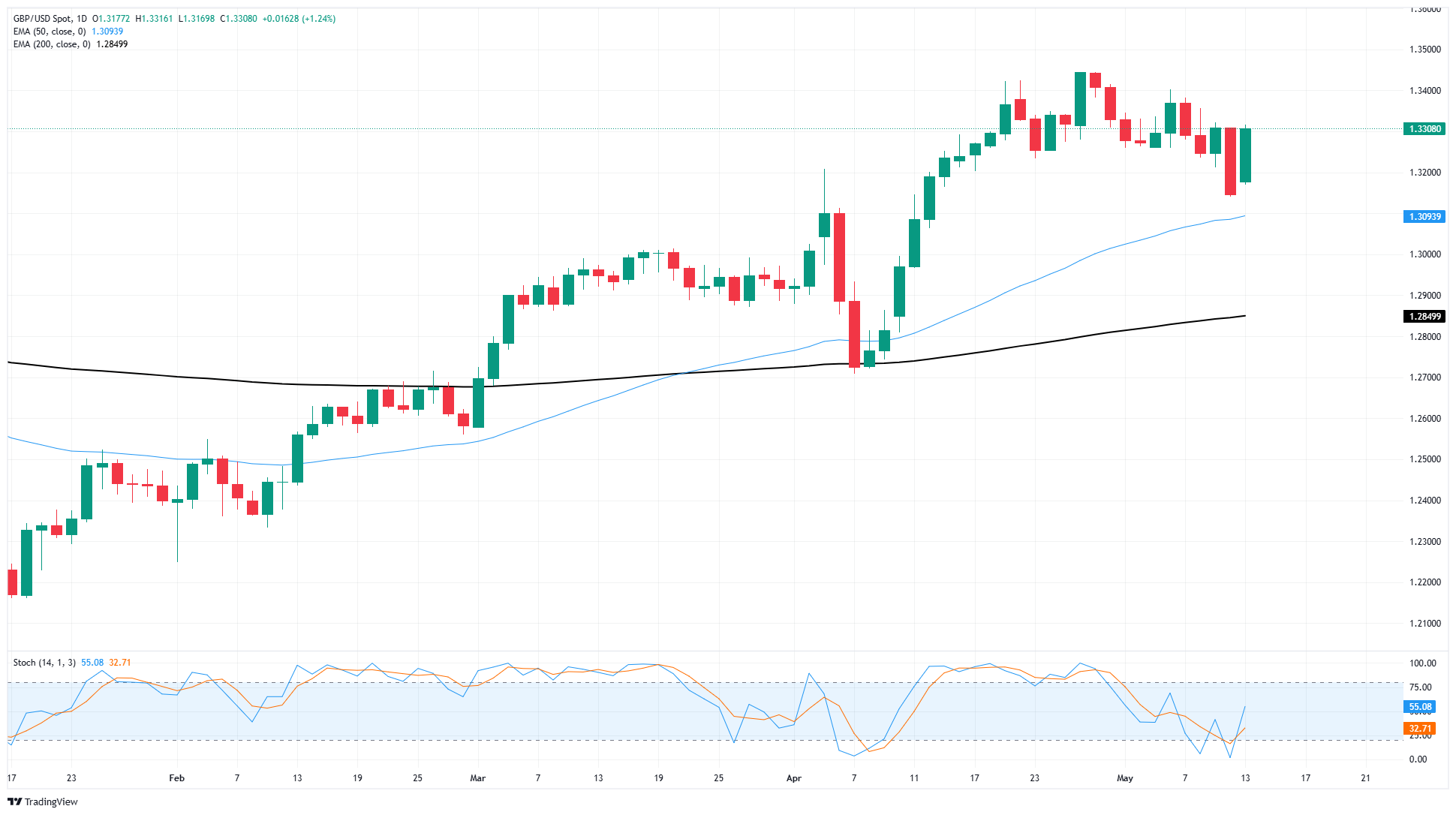GBP/USD enters a choppy phase as market sentiment churns
- GBP/USD rebounded above 1.3300 on Tuesday amid Greenback weakness.
- Markets took US inflation data in stride, investors continue to focus on US trade deal hopes.
- UK GDP growth figures loom ahead on Thursday, numbers are expected to come in mixed.
GBP/USD caught a bid on Tuesday, rebounding above the 1.3300 handle and reversing early week losses as global markets tilt and twist around general Greenback flows based on broad-market sentiment. UK labor figures barely moved the needle, and market reaction to US Consumer Price Index (CPI) inflation was likewise muted. Investors continue to focus on hopes that continued trade deal negotiations between the Trump administration and literally everybody else continues to drive general sentiment, however all trade tariff concessions delivered by team Trump have been strictly temporary in nature.
The UK’s quarterly ILO Unemployment Rate ticked slightly higher to 4.5% as expected, while Claimant Count Change in April rose far less than expected, rising to just 5.2K. However, the figure still wasn’t as good as March’s -16.9K contraction in the number of newly-unemployed workers. On the US side, CPI inflation eased slightly in April, with annualized headline inflation falling to a fresh three-year low. However, the Trump administration’s trade strategy of imposing triple-digit tariffs on its own major trading partners is expected to come home to roost beginning in May, and market experts are broadly expecting this to be the last decent CPI print for a while.
Pound Sterling markets will be waiting until Thursday for the latest batch of UK Gross Domestic Product (GDP) growth figures for the first quarter. Median market forecasts are expecting an upswing in QoQ GDP, anticipating Q1 GDP to rise to 0.6% QoQ versus the previous quarter’s 0.1%. On an annualized basis, forecasts expect last year’s GDP slump to still impact the data, forecasting QoY GDP to ease to 1.2% from 1.5%.
US Producer Price Index (PPI) inflation figures and the University of Michigan’s latest Consumer Sentiment Survey are also slated for the back half of the trading week. US PPI inflation will be printing on Thursday, with key consumer sentiment figures due on Friday.
GBP/USD price forecast
GBP/USD’s bullish reversal puts the pair on pace to enter a rough congestion pattern in the near-term. Price action has been in a choppy phase since slipping back from recent highs near 1.3450, but bearish momentum has been struggling to drag bids back down to the 50-day Exponential Moving Average (EMA) near 1.3100.
GBP/USD daily chart

Pound Sterling FAQs
The Pound Sterling (GBP) is the oldest currency in the world (886 AD) and the official currency of the United Kingdom. It is the fourth most traded unit for foreign exchange (FX) in the world, accounting for 12% of all transactions, averaging $630 billion a day, according to 2022 data. Its key trading pairs are GBP/USD, also known as ‘Cable’, which accounts for 11% of FX, GBP/JPY, or the ‘Dragon’ as it is known by traders (3%), and EUR/GBP (2%). The Pound Sterling is issued by the Bank of England (BoE).
The single most important factor influencing the value of the Pound Sterling is monetary policy decided by the Bank of England. The BoE bases its decisions on whether it has achieved its primary goal of “price stability” – a steady inflation rate of around 2%. Its primary tool for achieving this is the adjustment of interest rates. When inflation is too high, the BoE will try to rein it in by raising interest rates, making it more expensive for people and businesses to access credit. This is generally positive for GBP, as higher interest rates make the UK a more attractive place for global investors to park their money. When inflation falls too low it is a sign economic growth is slowing. In this scenario, the BoE will consider lowering interest rates to cheapen credit so businesses will borrow more to invest in growth-generating projects.
Data releases gauge the health of the economy and can impact the value of the Pound Sterling. Indicators such as GDP, Manufacturing and Services PMIs, and employment can all influence the direction of the GBP. A strong economy is good for Sterling. Not only does it attract more foreign investment but it may encourage the BoE to put up interest rates, which will directly strengthen GBP. Otherwise, if economic data is weak, the Pound Sterling is likely to fall.
Another significant data release for the Pound Sterling is the Trade Balance. This indicator measures the difference between what a country earns from its exports and what it spends on imports over a given period. If a country produces highly sought-after exports, its currency will benefit purely from the extra demand created from foreign buyers seeking to purchase these goods. Therefore, a positive net Trade Balance strengthens a currency and vice versa for a negative balance.
